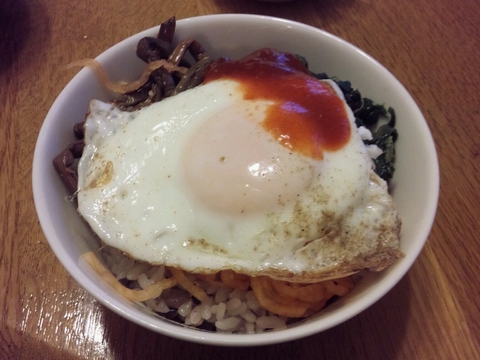ビビンバ
色とりどりの野菜の和え物、卵、そして肉が乗ったビビンバは、日本人が
大変よく知っている韓国料理の一つだと思います。
■ビビンバ

ビビンバの上にある野菜は、ナムルといい、火の通った野菜をニンニク、塩、
ごま油で軽く和えたものです。
日本ではナムルが単体で売られているのをよく目にしますが、実際にビビンバは
自宅でも簡単に作ることができます。
ご飯の上に、ナムル、半熟のゆで卵を乗せ、コチュジャンとごま油を用意すれば
出来上がりです。
韓国式の食べ方は、スプーンでとにかくよく混ぜることです。
きっちり混ぜて食べれば、ひと口でも十分に栄養補給をすることができます。
元々、ビビンバは年末の食べ物で、年内の食べ物は年内に食べて年越しをしない、
という古くからある風習に乗っ取るものです。
しかし、最近よく言われるのは、ビビンバは、ご飯やお肉からエネルギーを摂取し、
そのほかにも野菜や卵、ごま油とかなりバラエティ豊かな栄養素を取り揃えており、
万能な食事として知られています。
どんぶり一杯で、栄養バランスの整った食事ができるというわけです。
ナムルは、麺に合わせてもいいですし、同じお米文化の日本人にとって、
食べ方のアレンジがしやすいので、沢山作っておいてもいいでしょう。
コチュジャンが苦手という人は、塩コショウなどで味の濃さを調節してもいいと
思います。
スポンサードリンク
ビビンバの材料(1人前)
・ご飯…どんぶり2/3杯
・ナムル…各大さじ2杯(もやし、キムチなどお好みのナムルを利用)
・コチュジャン…小さじ1杯
・半熟目玉焼き又は温泉卵…1個分
・ごま油…少々
Bibimbap
Bibimbap arranged with marinated colorful vegetables, eggs, and meat is one of the well-known Korean food in Japan.
Vegetable on bibimbap is called namul, which is cooked vegetables lightly marinated with garlic, salt, and sesame oil.
Although namul is often seen to be sold by itself in Japan, actually bibimbap is easy to cook at home.
It can be made by arranging namul and soft boiled egg on rice and preparing red pepper paste and sesame oil.
Korean-style is to mix well with a spoon in any case.
If you thoroughly mix and eat it, you can have enough nutrition even at a mouthful.
Originally, bibimbap is eaten at the end of the year.
It is becuase there is an old custom to eat the food within the same year and not to eat it after the year is out.
However, it is often said recently that bibimbap is well-known as the versatile meal as rice and meat provide energy and it has a variety of nutrients such as vegetables, eggs, and sesame oil.
You can take a nutritionally well-balanced food in a bowl.
Namul is suitable for noodles. It is useful to make a lot of namul as it is easy to utilize for Japanese who have the same rice culture.
The taste can be adjusted with salt and pepper if you do not like gochujang.
Sponsored Link